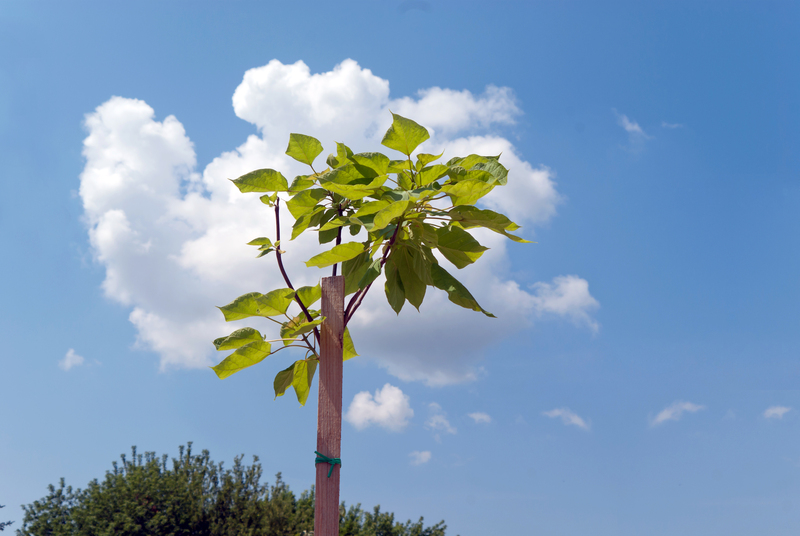Green thumb tips for nurturing a lush herb garden at home
Posted on 20/06/2025
Green Thumb Tips for Nurturing a Lush Herb Garden at Home
Imagine reaching for freshly picked basil while cooking, inhaling the sweet aroma of mint as you walk by, or snipping rosemary straight into your favorite dish. A thriving herb garden can transform your home into a green paradise and elevate your culinary experience. But how do you ensure success? This comprehensive guide shares green thumb tips for nurturing a lush herb garden at home, covering everything from choosing the right herbs to troubleshooting common problems. Whether you're a beginner or an experienced gardener, these insights will help you cultivate a vibrant, fragrant, and productive herb oasis right in your living space.
Understanding the Basics of Herb Gardening at Home
Herbs are some of the most rewarding plants to grow at home. They're relatively low maintenance, offer instant gratification in the kitchen, and add both greenery and fragrance to your indoor or outdoor spaces. Before you get started, let's clarify some foundational concepts:
- Herbs can be annuals (live for one season), biennials (live for two seasons), or perennials (live for several years).
- Most culinary herbs like basil, parsley, and cilantro are annuals or biennials, while rosemary, thyme, and oregano are perennials.
- Herb gardens can thrive on sunny windowsills, balconies, patios, or garden beds.
- Growing herbs offers both fresh flavors and impressive health benefits.

Picking the Perfect Location for Your Indoor or Outdoor Herb Garden
Choosing the right spot is essential for lush, healthy herbs. Here are some green thumb tips for choosing your herb garden's location:
Light Requirements
Sunlight is crucial for most herbs. Aim for at least 6 hours of direct sunlight per day. South-facing windows or balconies are ideal indoors; outdoors, select a spot that isn't shaded by trees or buildings. If you lack natural light, consider using LED grow lights to supplement.
Drainage
Herb roots are sensitive to waterlogging. Whether you grow in pots or in-ground beds, ensure there's good drainage to prevent root rot. Pots should have holes at the bottom, and outdoor beds may benefit from raised mounds or added sand for improved percolation.
Accessibility
Place herbs where you can easily access them for both harvesting and maintenance. The easier it is to reach your plants, the more often you'll use them and notice if they need attention.
Selecting the Right Herbs for a Robust Home Garden
Not sure which herbs to plant? Here are some of the easiest and most popular culinary herbs that thrive both indoors and outdoors:
- Basil: Loves sun and warmth; perfect for summer pesto and salads.
- Mint: Vigorous grower (keep contained); adds zest to drinks and desserts.
- Parsley: Biennial; crisp, fresh flavor for garnishes and dressings.
- Rosemary: Perennial with needle-like leaves and fragrant aroma; great for roasting.
- Thyme: Compact perennial; ideal for soups, roasts, and seasoning.
- Cilantro: Fast-growing annual; essential for salsas and curries.
- Oregano: Hardy perennial; classic in Italian and Mediterranean cuisine.
- Chives: Mild onion flavor; tasty in salads, eggs, and spreads.
Start with 3-5 of your favorites. Remember that variety increases resilience and makes your herb garden more interesting.
Consider Companion Planting
Certain herbs grow better together and can help each other resist pests. For example, basil and tomatoes are classic companions, while mint is best grown alone because it tends to spread aggressively.
Preparing Soil and Containers for Herb Gardening Success
Whether you're using raised beds, pots, or direct garden planting, soil quality is key:
- Use light, well-drained potting soil with a mix of compost for nutrients.
- Add perlite or coarse sand for improved drainage, especially for Mediterranean herbs like rosemary and thyme.
- Avoid heavy clay soils, which retain too much moisture and can cause root rot.
- Container size matters: Most herbs thrive in containers that are at least 6-8 inches deep and wide.
- For attractive displays, use windowboxes, tiered planters, or group pots together for a mini-herb garden effect.
Organic Gardening Tip
Use organic compost and fertilizers to enrich your soil and keep your herbs chemical-free for safe kitchen use.
Practical Planting Tips for Thriving Herbs
Now that you have your site, soil, and herbs selected, it's time to plant:
- Follow proper spacing: Crowded herbs compete for light and nutrients. Read each herb's tag or packet for spacing guidance.
- Plant seeds or seedlings: Some herbs, like basil and cilantro, are easy to sow directly. Others, like rosemary, are best started from nursery plants.
- Water thoroughly after planting, but let the top inch of soil dry out before watering again (most herbs dislike soggy roots).
- Add a thin mulch of straw or fine bark outdoors to retain moisture and suppress weeds.
Starting from Seeds vs. Transplants
Growing herbs from seed is cost-effective and satisfying, but buying healthy young plants gives you a head start, especially for perennials like rosemary and sage.
Essential Watering and Feeding Guidelines for Lush Herbs
Understanding when and how to water your herbs can make all the difference. Here are herb garden watering tips:
- Check soil moisture regularly by sticking your finger an inch below the surface.
- Water deeply but infrequently. Let the soil dry out slightly between waterings for healthy root growth.
- Early morning is best to reduce evaporation and fungal risk.
- Container herbs generally need more frequent watering than garden beds.
- Avoid wetting the foliage, especially at night, to minimize disease.
Fertilizing Homegrown Herbs
Herbs grown for leaves need regular feeding, but too much fertilizer can lower their flavor. Use an organic, balanced fertilizer (such as a slow-release 5-5-5 formula) every 4-6 weeks. Liquid seaweed or fish emulsion is also excellent in moderation.
Smart Pruning and Harvesting Techniques for Maximum Growth
Regular harvesting and smart pruning are vital for keeping your herb garden lush and productive:
- Pinch back tips regularly to encourage bushier growth and prevent plants from becoming leggy.
- Harvest frequently, taking only the top few inches at a time; this signals the plant to produce more stems and leaves.
- Never remove more than one-third of a plant's growth at once to avoid stressing it.
- Basil, mint, and thyme all respond well to frequent pinching.
- Remove flower buds (especially on basil and cilantro) to prolong leafy growth, as flowering signals the end of their life cycle.
How and When to Harvest Various Herbs
Leafy herbs like basil are best harvested in the morning, just after dew has dried. Perennial woody herbs like rosemary and sage can be pruned throughout the growing season, but avoid heavy pruning in late fall before winter dormancy.
Pest and Disease Management for Healthy Home Herb Gardens
Keep your herbs thriving by preventing and addressing pest or disease issues early:
- Aphids, spider mites, and whiteflies are common on indoor and outdoor herbs. Spray with water or use neem oil for organic control.
- Practice good air circulation and avoid wetting leaves to minimize fungal diseases like powdery mildew.
- Check plants regularly for damage or discoloration and remove affected leaves promptly.
- Encourage beneficial insects like ladybugs and lacewings to help control pests naturally.
Tip: Companion planting with herbs like chives or basil can also deter pests from neighboring plants.
Seasonal Care and Overwintering Tips for Perennial Herbs
If you want your herb garden to thrive year after year, it's essential to understand seasonal needs:
Indoor Herbs in Winter
- Move containers indoors before the first frost.
- Place herbs in the sunniest window or supplement with grow lights.
- Reduce watering as growth slows in cooler, darker months.
- Check for pests like spider mites, which are more common indoors during winter.
Outdoor Perennials
- Mulch rosemary, thyme, and oregano with straw or leaves to insulate roots from freezing temperatures.
- Cut woody herbs back lightly after the last frost in spring to encourage lush new shoots.
Creative Ideas to Display and Use Fresh Herbs at Home
Your lush home herb garden can be both practical and beautiful. Here are some creative ideas for displaying and enjoying your herbs:
- Vertical wall planters are perfect for small spaces and make stunning green backdrops.
- Hang windowboxes inside your kitchen for convenient access and a splash of color.
- Group herbs by water and light needs for easier care and visual balance.
- Use attractive terracotta or ceramic pots for a rustic look.
- Gift homegrown herb bouquets as fragrant, edible presents for friends or neighbors.
- Dry or freeze surplus herbs for year-round use.

Pro Tips for Continuous Herb Success
To truly master your green thumb, remember these final herb garden care tips:
- Label each plant (especially in the beginning) to avoid confusion as herbs grow and mature.
- Keep a garden journal to note planting dates, varieties, and observations. This helps with planning and troubleshooting.
- Experiment with lesser-known herbs like tarragon, lemon balm, and lovage for fresh culinary adventures.
- Engage kids and family--caring for herbs is an educational, rewarding hobby for all ages.
Conclusion: Grow Your Own Herb Paradise
With these green thumb tips for nurturing a lush herb garden at home, you're well-equipped to start, maintain, and enjoy a gorgeous, fragrant, and tasty collection of your favorite herbs. From choosing the right location, varieties, and soil to mastering watering, pruning, and harvesting techniques, creating a healthy herb oasis is easier than ever. Not only will your home look and smell amazing, but you'll also enjoy the joy and health benefits that come from cultivating your own fresh ingredients--truly the mark of a masterful home gardener!
Get your hands in the dirt, experiment, and relax--soon, your indoor or outdoor space will be brimming with homegrown flavor and vibrant life.

